The Egyptian pyramids are one of the supreme structures of historical Egyptian civilization. They are pieces of art and significant inventions of Ancient Egypt modeled after the primordial mound.
These pyramids were faced with furbished, highly reflective white limestone, which gave them a glorious view.
Giza is home to the most famous Egyptian pyramids on the outskirts of Cairo. Unsurprisingly, many Giza pyramids are among the world’s most giant constructions.
The Pyramid of Khufu, one of the three pyramids of Giza, is the only one of the Seven Wonders of the Ancient World still standing in Egypt today.
Here is the list of the top 10 fascinating Pyramids in Egypt with details.
10. Pyramid of Ahmose
Content
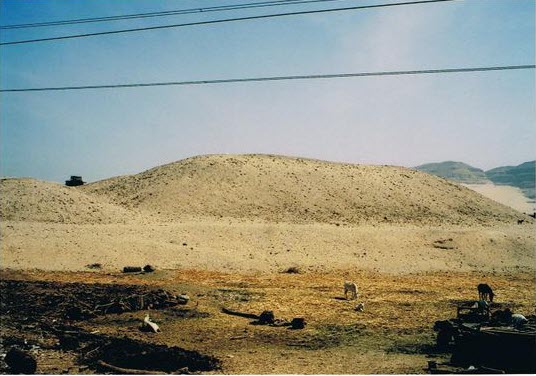
The Pyramid of Ahmose, located at the necropolis of Abydos, Egypt, is the last Egyptian pyramid discovered in Egypt by archeologists.
Since Egyptian Pharaohs from the 12th Dynasty were buried in secret underground tombs in sites like The Valley of the Kings, it was created using mud bricks over stones.
The Ahmose Pyramid complex at Abydos consists of a temple, a vast – unfinished rock-cut tomb in the desert. Beyond that, at the foot of the cliffs, a stone and brick-walled platform possibly designed to support a building that appears to have never been built.
The brick shrine dedicated to Ahmose’s grandmother, Tetisheri, stands midway between the pyramid and the tomb. And it contains a stela recording Ahmose’s choice to create a shrine for her.
The most intriguing part of Ahmose is that it signaled the end of the Pyramid age in Egypt and, to some extent, a changing of the guards in funerary practices.
The first pyramids were dedicated to the sun deity Re, but the mythology surrounding the funeral god Osiris was interwoven into the later pyramids’ substructures even before Ahmose.
9. Pyramid of Hawara
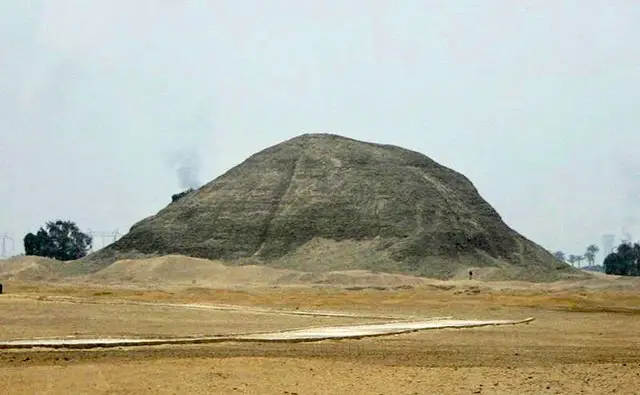
Amenemhat III, the Pharoah of the 12th dynasty, built the Hawara Pyramid, located at the east of the oasis of Faiyoum.
The Hawara Pyramid, formerly a formidable Labyrinth building, had extensive security measures and was made of mud-brick rather than stone.
Amenemhat III built the entrance to his pyramid in the southern portion, distinguishing the Pyramid of Hawara from prior pyramids constructed during the Old Kingdom period.
All other old pyramids followed the traditional practice of having the entrance in the northern half.
With the unique design, the idea of deceiving thieves who would wish to steal the valuables placed inside the pyramid was planted by the King.
8. Pyramid of Unas
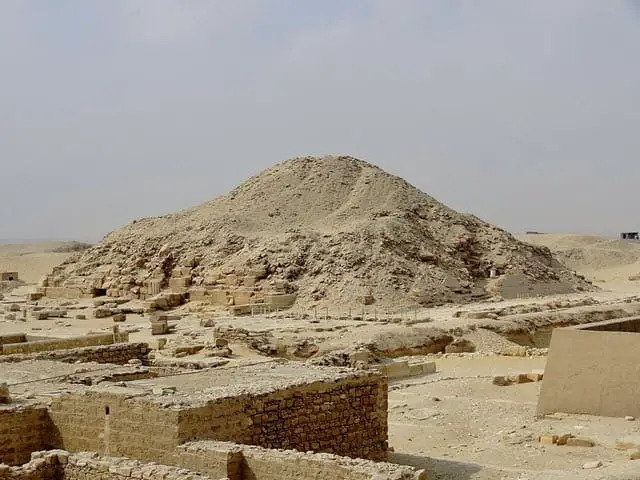
The Pyramid of Unas was built in the southwestern direction of the funerary of the 5th dynasty’s last Egyptian Pharoah, Zoser.
The pyramid was about 43 meters tall, with a unique representation of the beginning of the improvement in burial rituals.
The pyramid of Unas is exceptionally famous for its vertical columns of “hieroglyphic inscriptions” – the pyramid texts.
The text contained 712 utterances, a collection of magical spells assembled in no fixed order. The significance of these texts was to assure the King of a happy afterlife.
Several massive shaft tombs surround the Pyramid of Unas, dating from the Saite era (664–525 BC) and the Persian period (525–404 BC).
7. Pyramid of Userkaf
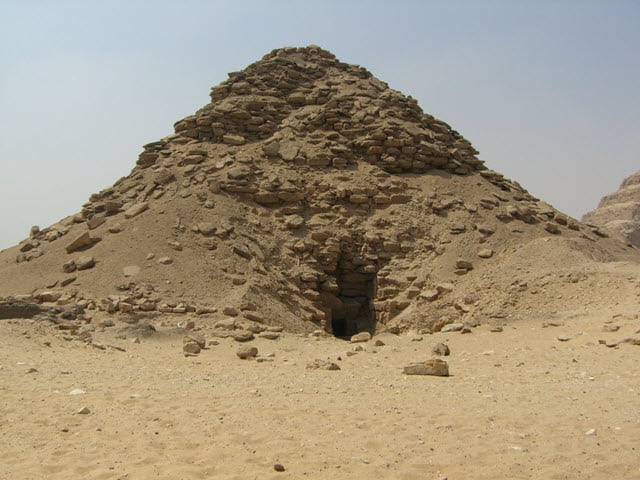
The pyramid of Userkaf, located at Sakkara, was constructed by Pharaoh Userkaf, the first ruler of Egypt’s 5th Dynasty. He reigned for seven years and was buried in this pyramid after his death.
It is famous as El-Haram el-Maharbish, the “Heap of Stone” among the locals.
The pyramid was initially high and large with an inclination of 53° identical to that of Khufu’s great pyramid for total volume. Small blocks of local limestone were used to construct the core of this pyramid.
The pyramid’s outer shell has been removed, leaving it as a mass of debris. A portion of the open court’s black basalt floor can still be seen.
6. Pyramid of Meidum

The pyramid of Meidum, located at Medium, on the Westbank of the Nile river, to the East of Lake Moris, and the Fayum oasis, is often referred to as the “collapsed pyramid” because it is in a destroyed state.
It was constructed by the last ruler of the 3rd dynasty, Huni, in accretion layers, the same as other pyramids. In contrast to other pyramids, each level was given a smooth exterior layer.
It was initially intended to be a seven-step pyramid, with an additional level added once the building was far along. It was transformed into the first genuine pyramid by filling the steps and covering them with limestone.
As a result, the last layer was supported by three limestone pieces and sand rather than solid rock.
5. Pyramid of Djoser
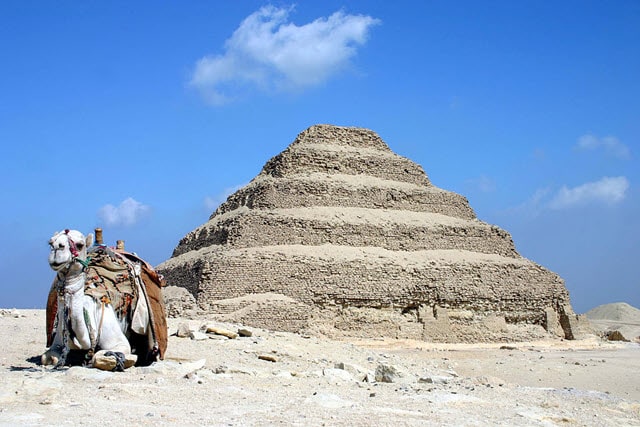
The Djoser Pyramid, located in Saqqara necropolis, was built between 2630 and 2611 BC. It was built in Saqqara as a tomb for King Djoser.
The Djoser Pyramid is 197 feet tall, with 11.6 million cubic feet of stone and clay used in its construction. Imhotep, a doctor, priest, and sculptor, among other things, is commonly credited with designing the pyramid. Initially, the tower was intended to be a typical mastaba, a flat-roofed tomb, but Djoser desired something grander.
The pyramid comprises six massive tiers of mastabas that get smaller as you get closer to the top. Djoser’s elevation to godhood is reflected in this design. The Pharaoh’s majesty and importance are also shown through the interior decorations.
Many inside walls adorn exquisite and vast carvings, and the burial chamber’s walls were covered with valuable blue glazed tiles.
4. North Pyramid or the Red Pyramid
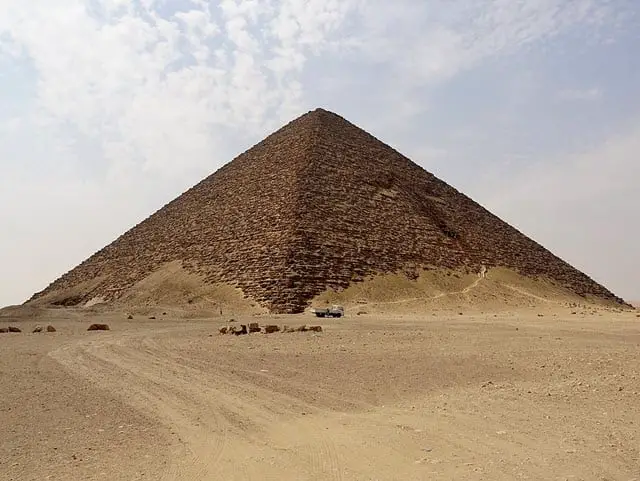
The red pyramid, often called the “North pyramid,” located at Dahshur cemetery in Cairo, Egypt, was built by King Snefru (reigned 2575–51).
This rusty, reddish structure is also the third-largest Egyptian pyramid. Egypt’s first attempt at building a “genuine” smooth-sided pyramid is likewise considered successful.
It is different than any other Egyptian pyramids due to its most extensive base, with each side measuring around 722 ft. Comparatively, it is a bit smaller than the Pyramid of Khufu.
With nearly 160 layers of stone, it is listed as the 4th highest pyramid in Egypt. And the use of red limestone in most of its parts was the main reason for naming it the Red Pyramid.
The pyramid’s foundation is made with numerous layers of proper white limestone that avoids the structural problems which plagued earlier pyramids of Egypt.
3. Pyramid of Khafre
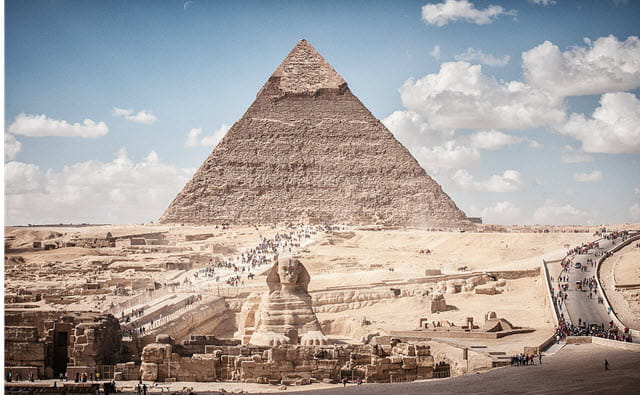
The second-largest pyramid in Egypt is the Khafre Pyramid, just around 10 meters lower than the Great Pyramid. The pyramid is exceptional because the original coating has retained the upper section.
Pharaoh Khafre, the son of Cheops and father of Menkaure, is claimed to have ordered the construction of this pyramid. The other two pyramids in the same funeral complex were dedicated to him.
It is a regular quadrangular pyramid with a square foundation measuring 210.5 meters. The deviance from a square of an ideal shape is only 8 cm, which is astonishing.
Pharaoh intended to construct the pyramid as a tomb and ensure that its essence would survive forever, as a symbol of authority and permanence beyond death. At that time, the Egyptians highly believe in life after death.
2. Pyramid of Menkaure
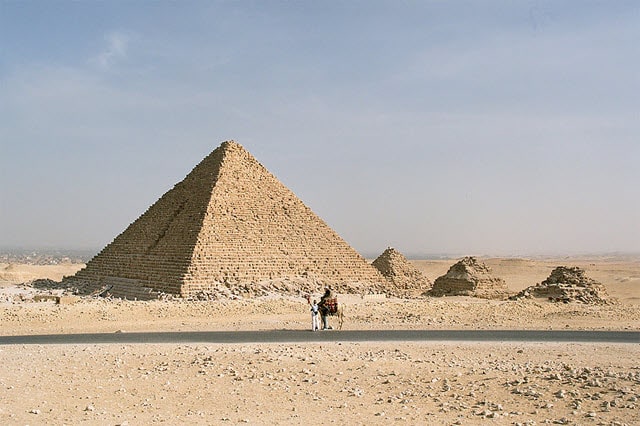
The Menkaure Pyramid is the plateau of Giza’s third pyramid. It symbolizes the end of the age of giant pyramids, being much smaller than Khufu and Khafra.
It is believed that this pyramid was built between 2532 and 2515 when Pharaoh Menkaure was ruling Egypt. He was a Pharaoh of the Fourth Dynasty.
At present, the Pyramid of Menkaure is 63m high. But when it was initially built, it was 65m high.
It has a 105-meter square base and a 51.20-degree inclination, which is quite near a perfect pyramid.
Except for the bottom 20 meters, i.e., the first 16 rows covered in pink granite, the entire pyramid was covered in a fine and white limestone layer with great perfection in the finish.
1. The Great Pyramid of Giza
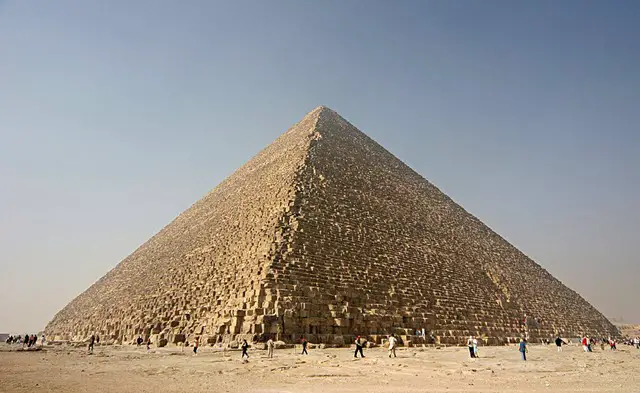
The great pyramids of Giza are one of the world’s most historic and notable human-created structural wonders. That’s why they are one of the seven wonders of the ancient world.
According to Egyptologists, the pyramid was built as a tomb for Egyptian Pharaoh Khufu of the Fourth Dynasty. It was constructed over 27 years in the 26th century BC.
The Great Pyramid was the world’s highest artificial structure for 3,800 years. It is standing at 146.5 meters (481 ft).
The pyramids were enlisted into the UNESCO World Heritage List in 1979.
It has backed initiatives to reduce the impact of tourism and regulate the growth of the nearby hamlet and the restoration of the Sphinx.
Conclusion
Besides the above-discussed pyramid, there are other essential pyramids such as the Pyramid of Djedefre, Pyramid of Teti, Pyramid of Lahun, and many more in Egypt with higher Egyptian religious values.
It resonates with power, accomplishments, authority, and privilege. On the other hand, the value of uniqueness and the distinctive function of the individual in the social arena is the polar opposite of this symbolism.
